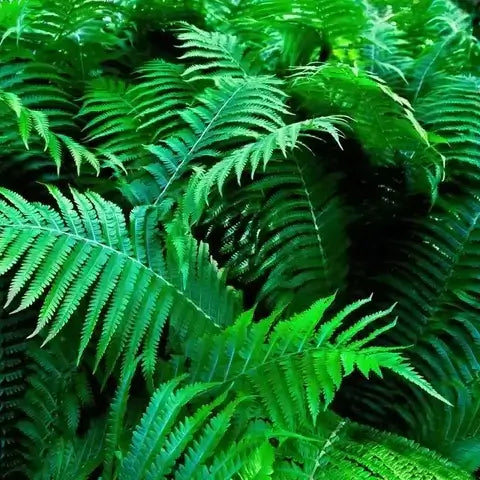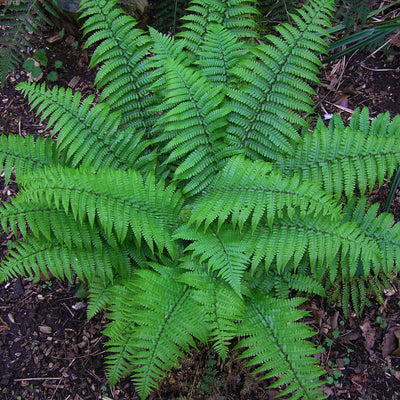Ferns do not flower, but they reproduce sexually via spores. They are a family of vascular, seedless plants. They are the second-most varied group of plants, following seed plants, with around 20,000 species. They cover a broad range of habitats, from temperate to tropical. Ferns prefer shady, moist environments.
Like seed plants, they have stems, roots, and leaves known as fronds. In contrast to plants, they reproduce via the spores. They have two generations in the life cycle, known as the alternative generation. Alternative generation is a term used to describe lifecycles that change between diploid and haploid species.
It is typical in terrestrial plants and algae. Haploid cells comprise only one group of chromosomes, and diploid cells possess two sets of chromosomes. This article will explore the life cycle of ferns, and we will also give suggestions for some beautiful ferns, so stay tuned!
The Life Cycle of Ferns
There are two distinct phases in the fern's life cycle. The mature plants release spores that find on the underside of leaves. After they germinate, they transform into heart-shaped, small plants called prothalli.
Female and male cells form from these plants. Once fertilized, adult ferns start to develop. To gather spores, put an area of mature fronds on the paper in a dry location. If the spores are grown, they will fall onto the paper. They will appear as a brown, black, or yellow powder that is composed of spores as well as fragments of cases of spores.
It is crucial to sterilize the germination mix before sowing the fern's spores by placing boiling water on it. It kills spores of the fungus and other plants that could sprout and engulf the growing fern prothalli.
Collecting spores
To collect spores, place an area of mature fronds on the paper in a dry location. If the spores have reached maturity, they will shed onto the paper and appear as a brown, black, or yellow powder made up of spores and fragments of spores (sporangia).
Method of sowing
It is crucial to sterilize the germination mix before sowing fern spores. It is done by placing boiling water on it. It eliminates spores from the fungi and other plants that can sprout and engulf the growing fern prothalli.
A surface liberally coated with spores such as finely chopped tree fern fiber, peat, or sphagnum moss. Equal amounts of loam peat moss, and finely crushed terracotta, spread to 2cm in depth over the vermiculite's foundation, make an excellent base for germination.
Once the seeds sow, the containers must be covered with glass or plastic (allowing some air space) to keep them at about 20 degrees C under indirect sunlight. Spores can take between 2 and 6 weeks to develop.
Potting on
In a few weeks, sprouting spores appear as an elongated growing, mossy growth. Once the prothalli have formed and fully developed, they may pull off to create punnets that contain an exceptionally finely sifted soil mix. The container should be surrounded with plastic or glass until the fronds appear. The developing ferns do not mean exposed to direct light.
The following ferns will add a touch of elegance to your garden:
The Christmas fern gets its name because it is always green, unaltered by the onset of winter dormancy in other perennial plants. Members of the Polystichum genus are among the toughest ferns, with remarkable resistance to extreme cold and other adverse conditions.
Even better, they need very little support from you to flourish throughout the year. All they require is water in the dry or hot periods of the season. The Christmas fern leaves are dark green, with a lighter shade of green. The fern's heads are green and covered with silvery-white scales. They let loose when you open.
The leaflets of the Christmas Fern are petite and circular. It contains between twenty and thirty-five leaflets alternately arranged on its stems. The leaflets are 1 1/2 inches long and include a base lobe. Also, they have bristle-tipped tips at their margins. They also possess a different shape, with a slight sway. When the old fronds die, new fronds will unfurl, leaving a green appearance throughout the year.
Giant Ostrich Fern
Ostrich Fern is a stunning ornamental plant that creates a strong and stylish accent in any partially-shaded setting. It is ideal for the rear of a garden border or in natural areas near water features, an acquisition, or any partially shaded area you could discover. The Northern Hemisphere's North America, Asia, and Europe continents are where the ostrich fern was first found.
The plant is a slender cluster. Each frond is a bright green, sturdy center stem and leaves with an elongated, lightly rounded sawtooth. The crowning glory is what gives the Ostrich fern its name. Each fertile frond is an ostrich crown with an enveloping green. The rosette's title curves upwards to create a tight spiral.
Lady Fern
The Lady Fern can grow between three to seven feet in diameter. But, this plant will maintain an enviable close-up. This tough plant is the perfect choice for any garden where you want to create a lush green background. It also works well in the ground as a cover for various uses.
The dry soil and firmness are ideal for this fluttery perennial plant. It is important to note that Lady Fern will adapt well to more dry soil and sunlight. It grows relatively fast and can grow up to five feet. It begins with fiddleheads, which then disappear and reveal delicate, long leaves. This plant is a beautiful greenery to any landscape and is easy to keep.
The deciduous plant appears delicate and elegant with elegant and lacey leaves. The fern's stems can have stunning red, purple, or green shades. It's a striking plant that adds beauty to any planted place. If you grow the fern on your property or in a garden for the community, people will all love the stunning plant. Once the fern has matured, it can flourish without any hassle. Because ferns are a perennial plant, it is possible to take pleasure in its growth for several years.
New York Fern
The exquisite, delicate appearance of New York ferns lends a sense of sophistication and gentleness to any scene. They are graceful, long leaves that arch upwards and create an enchanting natural green backdrop. New York ferns' extensive root system assists in stabilizing soil, which prevents erosion of steep slopes and banks. New York ferns create habitat and food sources for various wildlife species, including insects, birds, and smaller mammals.
Its fronds have a lance shape with an elongated tip. It can reach up to 2 feet in width. The leaflets are tiny and located at the bottom at the base of the leaf. The top that forms the root of the plant could be apparent, and it is dark brown. Leaflets develop in groups of shiny, bright green.
The New York fern grows in the forest's low ravines, wetlands, and streams close to them. It is remarkably tolerant of complete shade as well as mixed shade zones. The species is tolerant of filtered sunlight. However, you'll be most successful if the plant is in the shade. A New York fern needs to be more specific about the soil's quality.

